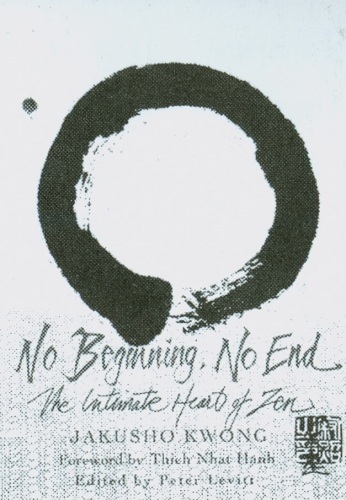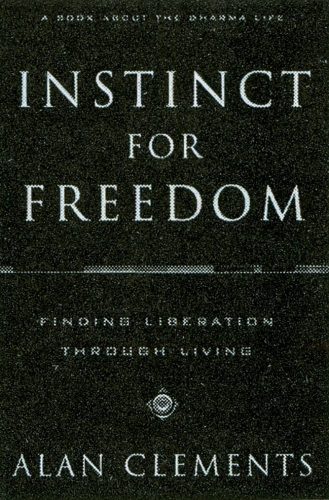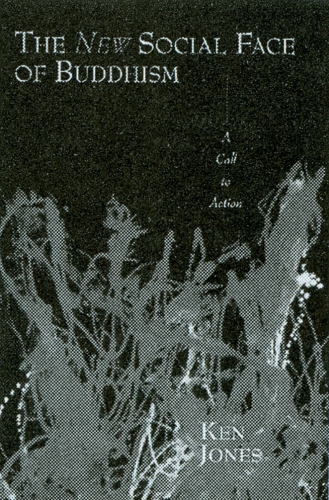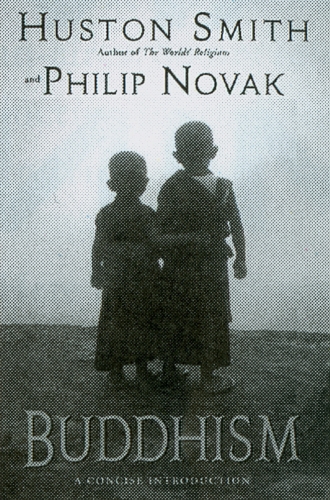 Though Shunryu Suzuki Roshi, founder of the San Francisco Zen Center, died in 1971, his influence lives on, as books by his students—and his students’ students—continue to roll out. Among the latest: No Beginning, No End: The Intimate Heart of Zen (Harmony Books, March, $18.95, cloth) by Jakusho (Bill) Kwong Roshi, one of Suzuki’s earliest students and one of his two designated heirs (transmission was cut short by the master’s death). This is Kwong Roshi’s first book, illustrated with his calligraphy and based on dharma talks delivered at his Sonoma Zen Center in Santa Rosa, California, and affiliate zendos in Poland and Iceland.
Though Shunryu Suzuki Roshi, founder of the San Francisco Zen Center, died in 1971, his influence lives on, as books by his students—and his students’ students—continue to roll out. Among the latest: No Beginning, No End: The Intimate Heart of Zen (Harmony Books, March, $18.95, cloth) by Jakusho (Bill) Kwong Roshi, one of Suzuki’s earliest students and one of his two designated heirs (transmission was cut short by the master’s death). This is Kwong Roshi’s first book, illustrated with his calligraphy and based on dharma talks delivered at his Sonoma Zen Center in Santa Rosa, California, and affiliate zendos in Poland and Iceland.
No Beginning is intended to be a companion piece to Suzuki Roshi’s classic, Zen Mind, Beginner’s Mind. The format is similar: short chapters, each headed by a pithy quote, organized into three sections roughly paralleling the process of awakening through Zen practice. Kwong’s teachings, in their intimacy and simplicity, evoke Suzuki’s sensibility.
The voice, however, is Kwong’s own. Alongside traditional Zen teaching tales are personal stories drawing on his forty years of Zen practice, as well as lessons from family and contemporary life. The anecdotes about Suzuki Roshi are fresh and illuminating; as Thich Nhat Hanh points out in his foreword, Kwong’s abiding love for his teacher is evident throughout. No Beginning may not achieve the iconic status of Zen Mind (which has sold over a million copies since its publication in 1970), but it is a pleasing introduction to Zen life, and to a wise and unassuming teacher.
Kwong Roshi’s editor, poet Peter Levitt, brings the perspective of his own longtime Zen practice to the process of making art in Fingerpainting on the Moon: Writing and Creativity as a Path to Freedom (Harmony Books, May, $21.00, cloth). “Creative acts . . . [bring] us face to face with our true nature,” Levitt notes.
Another teacher in Suzuki’s lineage, Zen monk and poet Norman Fischer—co-abbot of the San Francisco Zen Center from 1995 to 2000—looks at what it means to be mature in Taking Our Places: The Buddhist Path to Truly Growing Up (Harper San Francisco, May, $23.95, cloth). Asked to mentor four adolescent boys in the Zen community, Fischer met with them over a two-year period. Together, they explored qualities that define maturity—responsibility, experience, self-acceptance, love, stability, strength—as well as spiritual practices that might help one achieve it, from active listening and forgiveness to meditation and chanting. Like Fischer’s three-year-old Everyday Zen Foundation, the focus here is on bringing the dharma into daily life, for as broad an audience as possible.
Longtime practitioners may wish for a deeper investigation of such a complex subject—or at least more on what the Buddha thought. Fischer identifies maturity—growing into “the fullness of our humanity”—as the fruit of spiritual practice, but offers few specifics for cultivating it: “There is no last word. Maturity must be contemplated by each of us thoughtfully, and through action, as our lives unfold.” This may be the book’s ultimate wisdom: It raises that all-important question “What are we supposed to be doing with this life?” but in true Zen fashion, leaves us to find our own answers. A book, after all, is only a finger pointing at the moon.
Yet another branch of Suzuki’s lineage flows through Greens, the gourmet vegetarian restaurant in San Francisco that Zen Center opened in 1979. Executive chef Annie Somerville has followed up her award-winning Field of Greens with Everyday Greens (Scribner, May, $35.00, cloth). Illustrated with woodcuts by longtime Zen Center member Mayumi Oda, the cookbook offers advice on preparing exotic vegetables, pairing wines with greens, and composting, along with recipes.
Food plays an important role in Buddhist community life. For the cook, practice can be rigorous—and humbling. In Buddha’s Kitchen: Cooking, Being Cooked, and Other Adventures in a Meditation Center (Shambhala, May, $18.95, cloth) is Kimberley Snow’s amusing and insightful tell-all memoir of trading a high-powered job as an executive chef for the enlightening chaos of a Tibetan Buddhist retreat center kitchen.
Snow’s challenges, however, pale next to those of Georges B. J. Dreyfus, a Williams College religion professor who spent fifteen years studying in the traditional Tibetan monastic system. Entering Namgyal, the Dalai Lama’s monastery in Dharamsala, in 1970, Dreyfus became the first Westerner to complete the rigorous Gelug curriculum and earn the geshe designation. Part memoir, part scholarly exposition, The Sound of Two Hands Clapping: The Education of a Tibetan Buddhist Monk (University of California Press, January, $60.00, cloth; $24.95, paper) gives us a rare, in-depth look at daily life in a Tibetan monastic college and the course of study followed by the monks. The title refers to the method of intellectual debate central to Tibetan Buddhist scholarship, in contrast to the “mystical sound of one hand clapping” that characterizes the more intuitive practice of Zen koan study.
Few Westerners are likely to follow in Dreyfus’s footsteps, but this peek behind the monastic curtain is riveting nonetheless—not least for finally answering the question of how Tibetan monks can memorize and recite hundreds upon hundreds of scrolls of religious text.
 Alan Clements’s Instinct for Freedom: Finding Liberation Through Living (New World Library, 2002, $22.95, cloth) offers another inside look at monastic life in Asia; Clements was the first American to become a Buddhist monk in Burma. From his notes and prodigious memory, Clements reconstructs an interview-by-interview account of five years’ study with the Vipassana teachers Mahasi Sayadaw and Sayadaw U Pandita. Alongside the dharma discourse, Clements relates his Indiana Jones-like adventures with forces opposing Burma’s repressive regime. (In all, he spent nearly a decade in Burma, toward the end of his stay co-authoring The Voice of Hopewith Aung San Suu Kyi, the 1991 Nobel laureate and leader of Burma’s nonviolent resistance.) Less clearly defined is Clements’s manifesto for a “world dharma” centered on “liberation through living” that makes social and political activism integral to spiritual awakening. With the world in such a mess, the impetus for a dharma of interrelatedness is strong, but how to realize it isn’t made clear.
Alan Clements’s Instinct for Freedom: Finding Liberation Through Living (New World Library, 2002, $22.95, cloth) offers another inside look at monastic life in Asia; Clements was the first American to become a Buddhist monk in Burma. From his notes and prodigious memory, Clements reconstructs an interview-by-interview account of five years’ study with the Vipassana teachers Mahasi Sayadaw and Sayadaw U Pandita. Alongside the dharma discourse, Clements relates his Indiana Jones-like adventures with forces opposing Burma’s repressive regime. (In all, he spent nearly a decade in Burma, toward the end of his stay co-authoring The Voice of Hopewith Aung San Suu Kyi, the 1991 Nobel laureate and leader of Burma’s nonviolent resistance.) Less clearly defined is Clements’s manifesto for a “world dharma” centered on “liberation through living” that makes social and political activism integral to spiritual awakening. With the world in such a mess, the impetus for a dharma of interrelatedness is strong, but how to realize it isn’t made clear.
 For that, readers can turn to The New Social Face of Buddhism: A Social Call to Action (Wisdom Publications, May, $16.95, paper), an expanded and updated edition of Ken Jones’s 1989 handbook of socially engaged Buddhism. Starting from the foundational idea that inner liberation and social liberation must proceed as one, Jones, a longtime social activist and Zen practitioner, elaborates on Buddhist social theory and on practices for inner transformation. Then, envisioning a “broadly inclusive . . . culture of awakening,” he outlines requisite action for “mainstreaming the dharma,” in order to address the world’s pressing problems: war, poverty, environmental degradation, and social injustice.
For that, readers can turn to The New Social Face of Buddhism: A Social Call to Action (Wisdom Publications, May, $16.95, paper), an expanded and updated edition of Ken Jones’s 1989 handbook of socially engaged Buddhism. Starting from the foundational idea that inner liberation and social liberation must proceed as one, Jones, a longtime social activist and Zen practitioner, elaborates on Buddhist social theory and on practices for inner transformation. Then, envisioning a “broadly inclusive . . . culture of awakening,” he outlines requisite action for “mainstreaming the dharma,” in order to address the world’s pressing problems: war, poverty, environmental degradation, and social injustice.
Tricycle contributing editor Charles Johnson, an English professor at the University of Washington, often writes about the dharma and social justice. In one essay from his new collection, Turning the Wheel: Essays on Buddhism and Writing (Scribner, June, $23.00, cloth), he uses the occasion of Toro Nagashi, a traditional Japanese lantern-lighting ceremony honoring the dead, to ponder what life would be like if we followed the Four Right Procedures, Pure Land teachings on nonviolence and good deeds.
Buddhism’s roots go back 2,500 years, but its history as we know it surfaced relatively recently, in the late eighteenth and nineteenth centuries. The Search for the Buddha: The Men Who Discovered India’s Lost Religion (Carroll & Graf, April, $26.00, cloth) tells the stories of the small, eccentric band of civil servants, adventurers, amateur archaeologists and linguists who crisscrossed southern Asia, unearthing Buddhist relics and long-lost stupas, and deciphering Sanskrit and Pali inscriptions and texts, to extricate the “secret religion of the sub-continent” from the overlay of Hindu and Islamic culture. The author, historian Charles Allen—descended from a long line of Anglos who served under the Raj—takes the view that without these passionate “Orientalist sahibs,” Buddhism would never have resurfaced or made it to the West. An interesting companion read to The Cult of Nothingness.
 For a short history of Buddhism as it traveled from Asia to America, as well as an overview of the current practice scene, seeBuddhism: A Concise Introduction (HarperSanFrancisco, March, $19.95, cloth) by the noted religion scholar Huston Smith and his former student Philip Novak, now a professor of philosophy and religion. The first part of the book expands on material from Smith’s masterwork, The World’s Religions. The section on Theravada Buddhism—given short shrift in the original—has been fleshed out, and the Theravada-Mahayana “great divide” is unpacked with a helpful chart comparing the two branches. Novak traces Buddhism’s growth in the West, particularly the new forms evolving in America, while Smith contributes a new afterword on the Pure Land tradition’s rising popularity in the U.S.
For a short history of Buddhism as it traveled from Asia to America, as well as an overview of the current practice scene, seeBuddhism: A Concise Introduction (HarperSanFrancisco, March, $19.95, cloth) by the noted religion scholar Huston Smith and his former student Philip Novak, now a professor of philosophy and religion. The first part of the book expands on material from Smith’s masterwork, The World’s Religions. The section on Theravada Buddhism—given short shrift in the original—has been fleshed out, and the Theravada-Mahayana “great divide” is unpacked with a helpful chart comparing the two branches. Novak traces Buddhism’s growth in the West, particularly the new forms evolving in America, while Smith contributes a new afterword on the Pure Land tradition’s rising popularity in the U.S.
Buddhism A to Z (Buddhist Text Translation Society, March, $21.95, paper) provides an overview in dictionary format. From abbot to Zhiyi (the Third Chinese Patriarch), there are definitions, with textual citations, of basic Buddhist terms, along with fascinating arcana, such as seven ways to bow and the history of the lotus position. Compiled by Ronald B. Epstein, a professor at the University of California, San Francisco, and director of the Institute for World Religions in Berkeley, this is probably the first Buddhist dictionary to declare itself a “work in progress” and to solicit suggestions and corrections from readers.